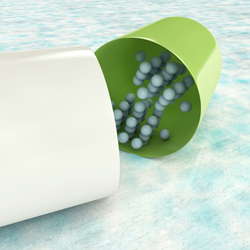Cancer targeting using nanocapsules
Small interfering RNA (siRNA), also called silencing RNA, are double-stranded RNA molecules about 20-25 base pairs in length. siRNA interferes with the expression of genes and selectively blocks protein synthesis. This could be the key to the development of innovative personalised therapies. The EU-funded project 'Transfection ability and intracellular pathway of LbL nanostructured siRNA delivery systems' (NANOSIRNA) worked on developing new technology to effectively deliver siRNA to cancer cells. Scientists will embed siRNA into multi-layered and multifunctional NCs to target pro-survival factors in human cancer cells. Degradable polymer NCs were chosen as they might better protect the encapsulated siRNAs from nuclease digestion and last longer than naked siRNAs. This would also improve their therapeutic potency. NCs were prepared using the Layer-by-Layer (LbL) strategy, which is based on the deposition of interacting polymers onto a porous colloidal template followed by core removal. Different types of NC were successfully designed and synthesised and subsequently characterised for their structural and functional properties. They were loaded with siRNA cargo, designed to target the mRNA encoding for the anti-apoptotic factor survivin. Results showed that under different experimental conditions, NCs were able to retain up to 85% of siRNA cargo and efficiently release it in a simulated intracellular environment. siRNA-loaded NCs displayed good biocompatibility in in vitro tests. Empty NCs, on the other hand, induced a perturbation of the intracellular environment. This would activate a cell safeguard mechanism that may limit the therapeutic effect in tumour cells. Several oral and poster reports were presented at international conferences. The success of NANOSIRNA project has led to the publication of four papers in peer-reviewed international journals. Project activities have demonstrated that NCs may represent a superior delivery system for siRNAs compared to lipid-based transfection systems. The results also highlighted the need for a careful evaluation of possible off-target effects that may influence the therapeutic exploitation of such nanodevices.
Keywords
Nanocapsules, vesicular, cancer, small interfering RNA, polymer, biocompatibility, transfection







